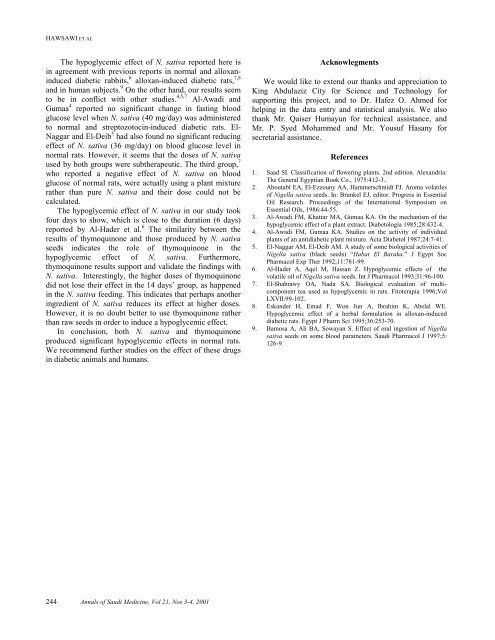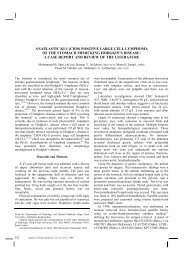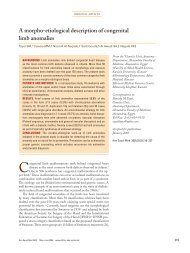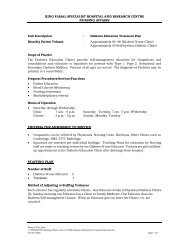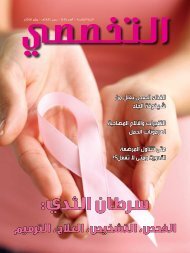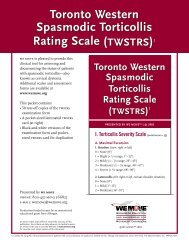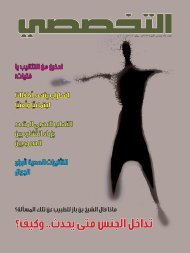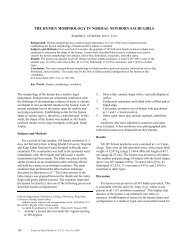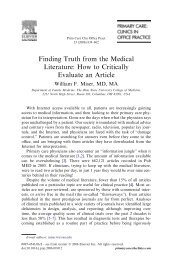effect of nigella sativa (black seed) and thymoquinone - ResearchGate
effect of nigella sativa (black seed) and thymoquinone - ResearchGate
effect of nigella sativa (black seed) and thymoquinone - ResearchGate
Create successful ePaper yourself
Turn your PDF publications into a flip-book with our unique Google optimized e-Paper software.
HAWSAWI ET ALThe hypoglycemic <strong>effect</strong> <strong>of</strong> N. <strong>sativa</strong> reported here isin agreement with previous reports in normal <strong>and</strong> alloxaninduceddiabetic rabbits, 6 alloxan-induced diabetic rats, 7,8<strong>and</strong> in human subjects. 9 On the other h<strong>and</strong>, our results seemto be in conflict with other studies. 4,5,7 Al-Awadi <strong>and</strong>Gumaa 4 reported no significant change in fasting bloodglucose level when N. <strong>sativa</strong> (40 mg/day) was administeredto normal <strong>and</strong> streptozotocin-induced diabetic rats. El-Naggar <strong>and</strong> El-Deib 5 had also found no significant reducing<strong>effect</strong> <strong>of</strong> N. <strong>sativa</strong> (36 mg/day) on blood glucose level innormal rats. However, it seems that the doses <strong>of</strong> N. <strong>sativa</strong>used by both groups were subtherapeutic. The third group, 7who reported a negative <strong>effect</strong> <strong>of</strong> N. <strong>sativa</strong> on bloodglucose <strong>of</strong> normal rats, were actually using a plant mixturerather than pure N. <strong>sativa</strong> <strong>and</strong> their dose could not becalculated.The hypoglycemic <strong>effect</strong> <strong>of</strong> N. <strong>sativa</strong> in our study tookfour days to show, which is close to the duration (6 days)reported by Al-Hader et al. 6 The similarity between theresults <strong>of</strong> <strong>thymoquinone</strong> <strong>and</strong> those produced by N. <strong>sativa</strong><strong>seed</strong>s indicates the role <strong>of</strong> <strong>thymoquinone</strong> in thehypoglycemic <strong>effect</strong> <strong>of</strong> N. <strong>sativa</strong>. Furthermore,<strong>thymoquinone</strong> results support <strong>and</strong> validate the findings withN. <strong>sativa</strong>. Interestingly, the higher doses <strong>of</strong> <strong>thymoquinone</strong>did not lose their <strong>effect</strong> in the 14 days’ group, as happenedin the N. <strong>sativa</strong> feeding. This indicates that perhaps anotheringredient <strong>of</strong> N. <strong>sativa</strong> reduces its <strong>effect</strong> at higher doses.However, it is no doubt better to use <strong>thymoquinone</strong> ratherthan raw <strong>seed</strong>s in order to induce a hypoglycemic <strong>effect</strong>.In conclusion, both N. <strong>sativa</strong> <strong>and</strong> <strong>thymoquinone</strong>produced significant hypoglycemic <strong>effect</strong>s in normal rats.We recommend further studies on the <strong>effect</strong> <strong>of</strong> these drugsin diabetic animals <strong>and</strong> humans.AcknowlegmentsWe would like to extend our thanks <strong>and</strong> appreciation toKing Abdulaziz City for Science <strong>and</strong> Technology forsupporting this project, <strong>and</strong> to Dr. Hafez O. Ahmed forhelping in the data entry <strong>and</strong> statistical analysis. We alsothank Mr. Qaiser Humayun for technical assistance, <strong>and</strong>Mr. P. Syed Mohammed <strong>and</strong> Mr. Yousuf Hasany forsecretarial assistance.References1. Saad SI. Classification <strong>of</strong> flowering plants. 2nd edition. Alex<strong>and</strong>ria:The General Egyptian Book Co., 1975:412-3.2. Aboutabl EA, El-Ezzouny AA, Hammerschmidt FJ. Aroma volatiles<strong>of</strong> Nigella <strong>sativa</strong> <strong>seed</strong>s. In: Brunkel EJ, editor. Progress in EssentialOil Research. Proceedings <strong>of</strong> the International Symposium onEssential Oils, 1986:44-55.3. Al-Awadi FM, Khattar MA, Gumaa KA. On the mechanism <strong>of</strong> thehypoglycemic <strong>effect</strong> <strong>of</strong> a plant extract. Diabetologia 1985;28:432-4.4. Al-Awadi FM, Gumaa KA. Studies on the activity <strong>of</strong> individualplants <strong>of</strong> an antidiabetic plant mixture. Acta Diabetol 1987;24:7-41.5. El-Naggar AM, El-Deib AM. A study <strong>of</strong> some biological activities <strong>of</strong>Nigella <strong>sativa</strong> (<strong>black</strong> <strong>seed</strong>s) “Habat El Baraka.” J Egypt SocPharmacol Exp Ther 1992;11:781-99.6. Al-Hader A, Aqel M, Hassan Z. Hypoglycemic <strong>effect</strong>s <strong>of</strong> thevolatile oil <strong>of</strong> Nigella <strong>sativa</strong> <strong>seed</strong>s. Int J Pharmacol 1993;31:96-100.7. El-Shabrawy OA, Nada SA. Biological evaluation <strong>of</strong> multicomponenttea used as hypoglycemic in rats. Fitoterapia 1996;VolLXVII:99-102.8. Esk<strong>and</strong>er H, Emad F, Won Jun A, Ibrahim K, Abelal WE.Hypoglycemic <strong>effect</strong> <strong>of</strong> a herbal formulation in alloxan-induceddiabetic rats. Egypt J Pharm Sci 1995;36:253-70.9. Bamosa A, Ali BA, Sowayan S. Effect <strong>of</strong> oral ingestion <strong>of</strong> Nigella<strong>sativa</strong> <strong>seed</strong>s on some blood parameters. Saudi Pharmacol J 1997;5:126-9.244 Annals <strong>of</strong> Saudi Medicine, Vol 21, Nos 3-4, 2001


